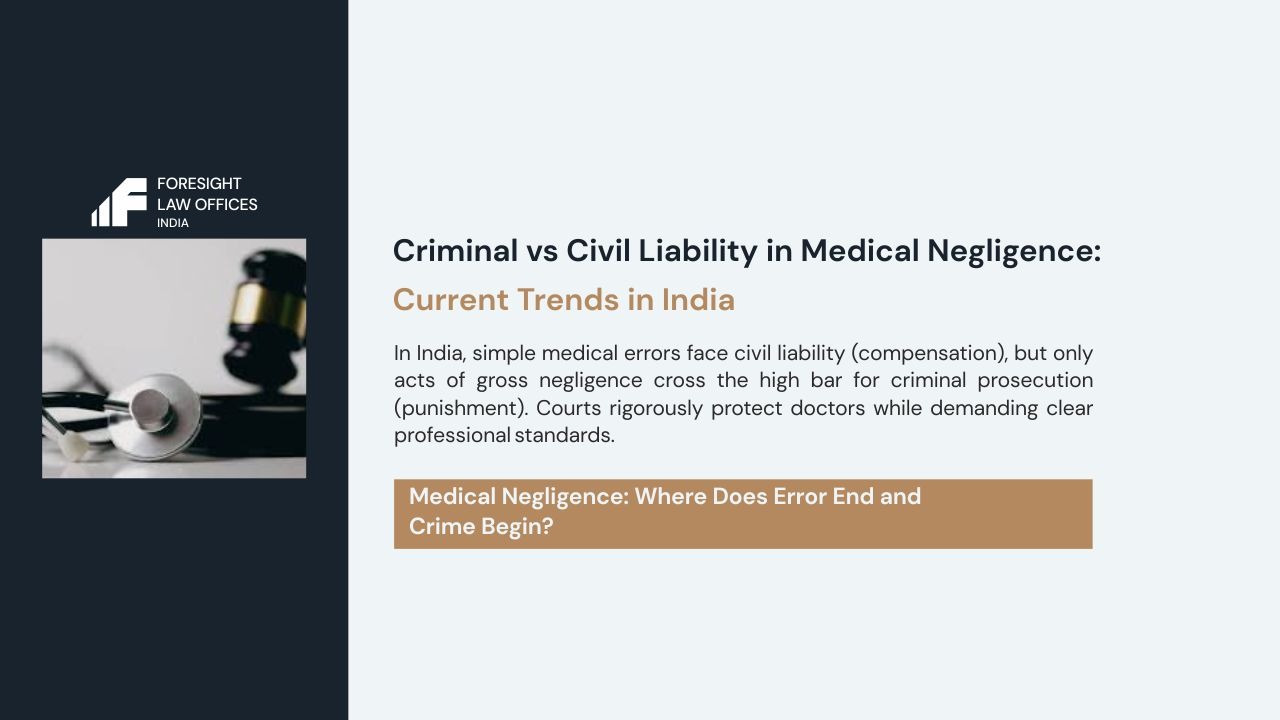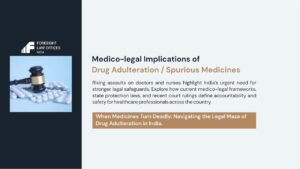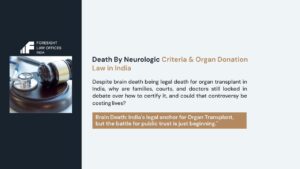In India, the relationship between the medical profession and the law has become increasingly complex. With rising awareness among patients and an expanding body of case law, courts now distinguish more carefully between civil negligence, which leads to compensation, and criminal negligence, which leads to punishment.
Understanding when a doctor’s lapse crosses the line from a civil wrong to a criminal offence is vital for both healthcare professionals and medico-legal lawyers advising them.
The Legal Landscape of Medical Negligence
Civil Liability
Civil liability arises when a patient suffers harm because a doctor failed to exercise reasonable care and skill. Such cases are typically filed under the Consumer Protection Act, 2019, or as tort claims for damages in civil courts. The goal is compensation, not punishment.
A civil court asks:
“Did the doctor act as a reasonable professional in similar circumstances?”
If the answer is no, liability arises. Compensation may be awarded for pain, suffering, loss of income, and future care costs.
Consumer Commissions across India, District, State, and National, continue to be the primary fora for such claims.
Criminal Liability
Criminal liability, on the other hand, involves moral blame and mens rea (a guilty mind). The object is not compensation but punishment for conduct that society deems grossly careless or reckless.
Under the Bharatiya Nyaya Sanhita, 2023 (BNS), which replaced the Indian Penal Code, medical negligence may attract:
- Section 106(1): Causing death by negligence (formerly IPC 304A)
- Section 108: Endangering human life or personal safety through negligent act
However, unlike in civil negligence, the threshold is much higher, mere error of judgment does not suffice. The prosecution must prove gross negligence or recklessness beyond reasonable doubt.
When and How Doctors Can Be Criminally Prosecuted
Doctors can face criminal prosecution in limited and exceptional circumstances where the alleged negligence goes beyond a mere mistake.
- The “Gross Negligence” Threshold
The Supreme Court, in Jacob Mathew v. State of Punjab (2005), laid down a protective shield for doctors:
“For negligence to amount to an offence, the element of mens rea must be shown to exist. A doctor cannot be held criminally liable for every mishap or error of judgment.”
The Court clarified that simple negligence gives rise to civil liability, whereas gross negligence or recklessness may invite criminal prosecution.
Gross negligence means a very high degree of negligence, an act or omission showing total disregard for the life and safety of the patient.
Examples include:
- Operating on the wrong organ or patient
- Administering a clearly contraindicated drug in fatal dose
- Refusing to attend a critical emergency despite being available
- The Procedural Safeguards
Following Jacob Mathew, courts and governments established procedural safeguards to protect doctors from frivolous prosecution:
- Expert Opinion Requirement:
No criminal complaint against a doctor should be entertained unless the complainant produces prima facie medical expert opinion supporting the charge of gross negligence.
- Sanction for Prosecution:
For government doctors, prior sanction under Section 197 of the Code of Criminal Procedure (now Section 218 BNS procedural equivalent) is mandatory before prosecution.
- Arrest as a Last Resort:
The Supreme Court directed that doctors should not be arrested routinely unless their custodial interrogation is necessary.
These safeguards ensure that criminal law is not misused as a tool of harassment.
Role of Standard of Care and Expert Testimony
- The Bolam Principle
The standard of care for medical professionals is guided by the Bolam Test, adopted from English law in Bolam v. Friern Hospital Management Committee (1957):
A doctor is not negligent if he has acted in accordance with a practice accepted as proper by a responsible body of medical professionals skilled in that field.
This means courts must evaluate whether the accused doctor’s conduct fell below the accepted standard within the profession, not whether a better alternative was available.
- Indian Courts’ Application
Indian courts consistently apply the Bolam principle, often supplemented by the Bolitho refinement (1997), which allows the court to reject expert opinion if it is not logically defensible.
Thus, expert testimony remains the cornerstone in medical negligence trials. Judges are not medical experts; they rely on professional testimony to understand whether the conduct in question was “grossly negligent.”
- Types of Experts Used
- Forensic medicine experts (for postmortem and cause of death)
- Specialists from the same discipline as the accused
- Independent medical boards constituted by government authorities
Without credible expert support, prosecution cases rarely survive judicial scrutiny.
(iv) Consumer Protection and Parallel Civil Claims
In several 2024–25 cases before the National Consumer Disputes Redressal Commission (NCDRC), civil liability has been imposed even where criminal charges were dismissed.
For example, in Mrs. Sunita Jain v. XYZ Hospital (2024), the NCDRC held that:
“While no gross negligence was proved for criminal action, the hospital is vicariously liable for lack of adequate monitoring staff, constituting civil negligence.”
Implication: Doctors may escape criminal punishment yet still face monetary liability under consumer law.
Comparative Perspective: The Shift After Bharatiya Nyaya Sanhita (BNS) 2023
The Bharatiya Nyaya Sanhita (BNS) retained the offence of causing death by negligence (Section 106) but introduced a slightly modernized structure.
For medico-legal lawyers, key takeaways include:
- The mens rea threshold remains unchanged; prosecution must still show gross or reckless conduct.
- Punishment remains up to two years or fine or both.
- There is renewed emphasis on professional standards—linking negligence to breach of statutory or recognized guidelines.
Thus, the BNS preserves judicially developed safeguards from the IPC era, signaling legislative continuity in balancing accountability with professional autonomy.
The Evolving Role of Medico-Legal Lawyers
With increasing public litigation and social media awareness, law firms handling medical matters are now playing a preventive role rather than just a defensive one.
|
Advisory Role |
Litigation Role |
|
|
The modern medico-legal lawyer thus straddles medicine, ethics, and law, acting as both protector and educator within the healthcare system.
Strengthening Trust Through Clarity
While courts have become more consistent in distinguishing civil and criminal negligence, confusion persists among the public. Media trials, emotional narratives, and misinformation often amplify hostility against doctors.
Reform directions include:
- Mandatory Medical Expert Panels: For all criminal complaints, before FIR registration.
- National Protocol Registry: Clearly defining clinical standards for high-risk procedures.
- Integrated Medico-Legal Training: For doctors, police, and judicial officers.
- Awareness Campaigns: Explaining to citizens the difference between an adverse outcome and medical negligence.
Ultimately, reducing litigation requires not just better laws, but better communication and documentation. As one Delhi High Court judge remarked in 2024:
“Transparent communication is the best prophylaxis against allegations of negligence.”
Conclusion
Medical negligence lies at the intersection of healing and accountability. The law does not expect perfection from doctors, but it does demand reasonable competence and honesty.
The current trend in 2025 shows Indian courts respecting medical judgment while cracking down on reckless or unethical conduct.
For healthcare providers, the message is clear, document thoroughly, communicate clearly, and adhere to professional standards.
For medico-legal lawyers, the responsibility is dual: to protect doctors from unfair prosecution and to ensure genuine victims receive justice. The ultimate goal is not to pit law against medicine, but to harmonize both in the service of patient safety and professional integrity.






